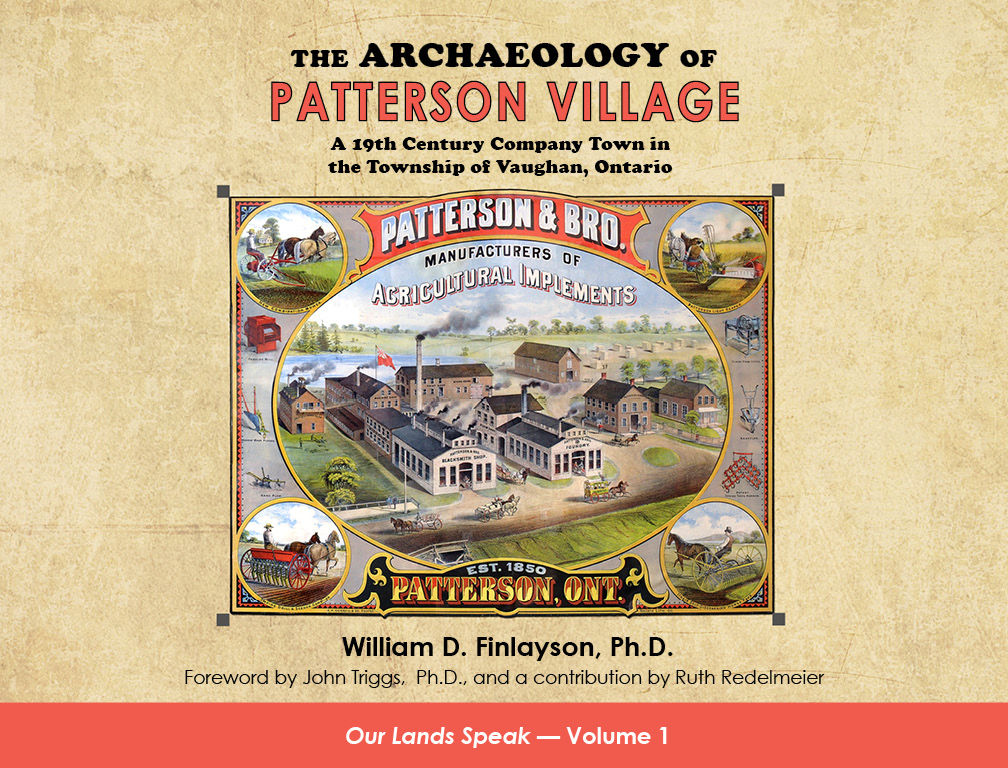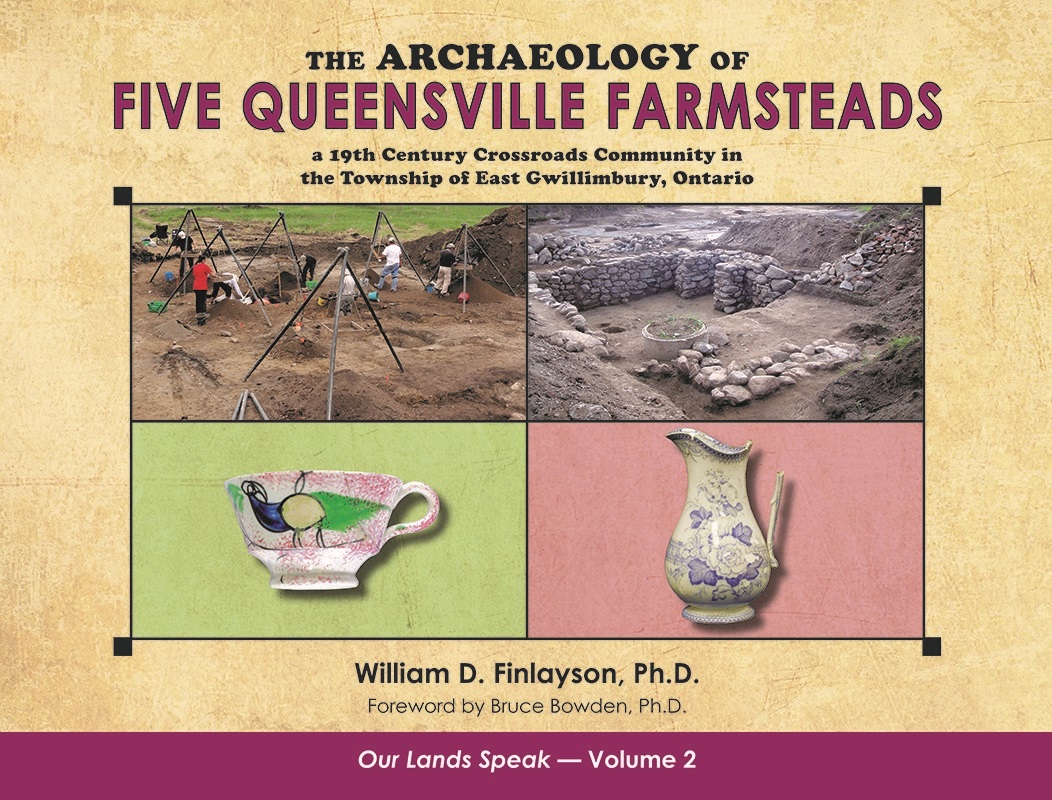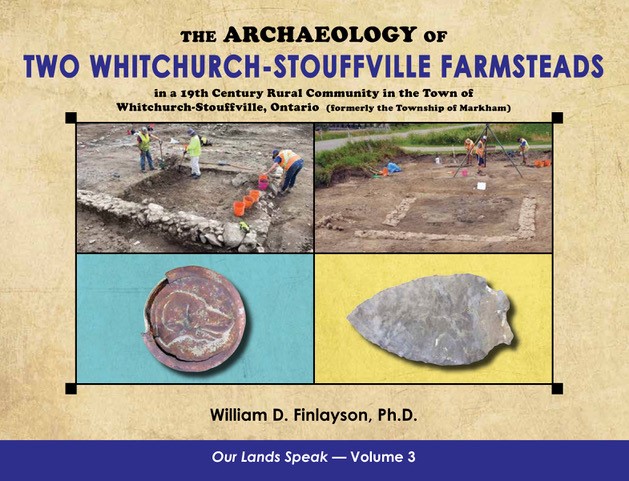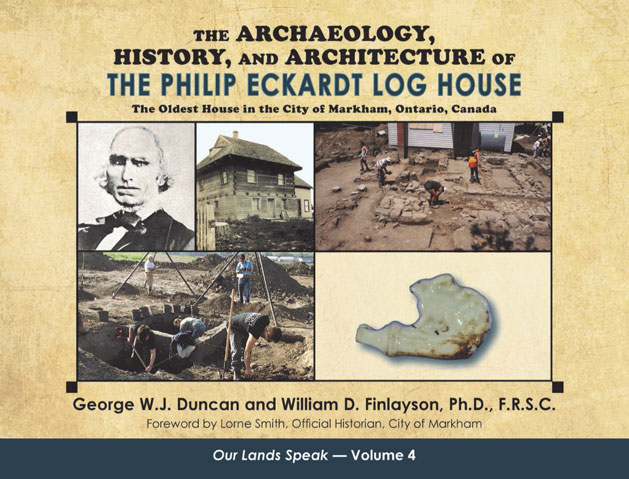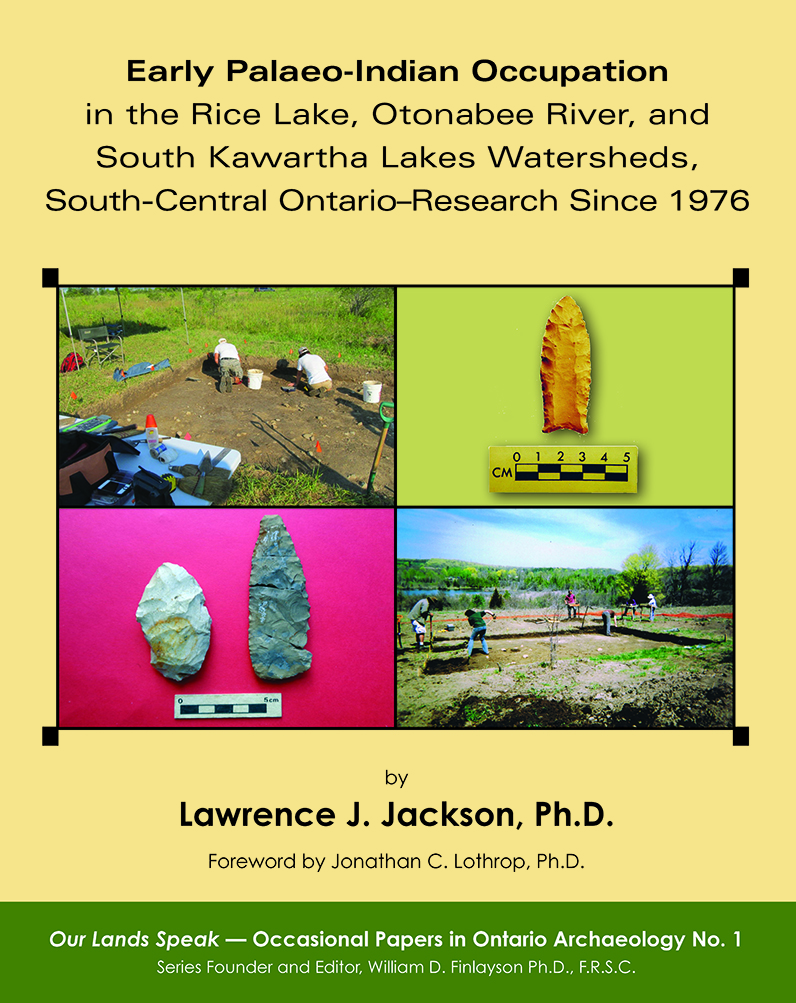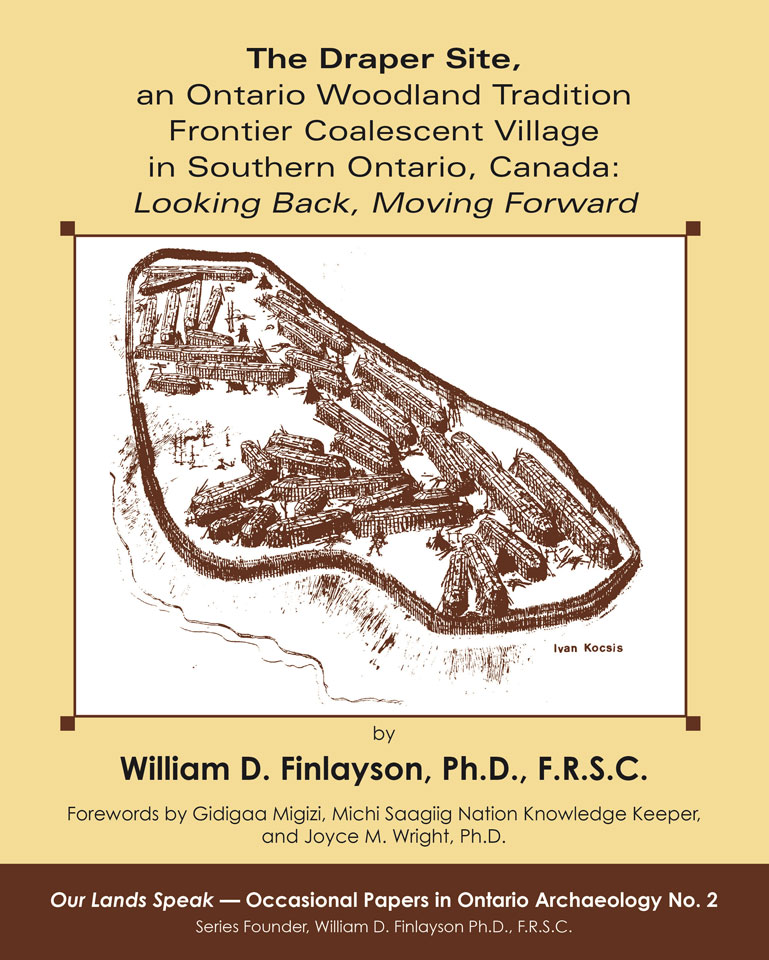Volume 1
The Archaeology of Patterson Village
Author William (Bill) Finlayson takes this simplistic definition, yet extraordinarily complicated field of study, and gives us a fascinating look into a piece of local Ontario history. Through the meticulously documented and analyzed “objects dug up from the ground,” we learn how the people of Patterson Village worked and socialized. Dr. Finlayson’s wonderfully descriptive prose, illustrations, and pictures, transport us back in time to the mid-1800s where we have a front-row seat to the lives of the people of Patterson Village.
The Archaeology of Patterson Village – A 19th Century Company Town in the Township of Vaughan, Ontario represents the largest excavation of a 19th century Euro-Canadian site in Ontario to date.
Between 1856 and 1888, Thomas Patterson and his brother operated one of the first farm equipment manufactories in the Township of Vaughan, Ontario. Patterson was a paternalist capitalist and established a company town which included 18 homes for married workers, and a boarding house for single men. For two years, This Land Archaeology Inc. worked on the complete excavation of the village. Findings included 16 cellars, and 36 privy pits in the subsoil. The excavations produced 291,911 artifacts as well as an estimated 1,113,097 small artifacts and preserved plant remains.
Shipping and applicable taxes $16.95
Total $51.90
Volume 2
The Archaeology of Five Queensville Farmsteads
William (Bill) Finlayson once again brings the past to life. This time, it is through the lives of the generations of people who settled in Queensville, Ontario. The Archaeology of Five Queensville Farmsteads – a 19th Century Crossroads Community in the Township of East Gwillimbury, Ontario affords us a glimpse into what life was like for the master builders of the Sharon Temple, a unique architectural structure in Canada. We learn how they, their families, and many others who built the community and made it their home, lived.
This crossroads community of Queensville, Ontario, was settled early in the 19th century primarily by Quakers; they were part of the Great Migration of about 20,000 people who fled the United States because of religious persecution. Some of these early settlers were actively involved in the Children of Peace, a break-away sect of Quakers who constructed the Sharon Temple.
Between 2008 and 2017, Bill’s company, This Land Archeology Inc. excavated five farmsteads south of the crossroads on both sides of Leslie Street. One of these farmsteads was owned for a time by Ebenezer Doan, one of the master builders of the Sharon Temple, and another by his son, Ira, and grandson, Ezra. The excavations produced tens of thousands of artifacts, cellars, and associated features including privies for each farmstead. These findings provide new insights into life in 19th century Queensville.
Shipping and applicable taxes $16.95
Total $66.90
Volume 3
The Archaeology of Two Whitchurch-Stouffville Farmsteads
In The Archaeology of Two Whitchurch-Stouffville Farmsteads, Bill shares that in the second half of the 19th century, John Yake Sr., a prominent Stouffville businessman, purchased two parts of Lot 32, Concession 10, in what is now the Town of Whitchurch-Stouffville. John Yake Sr. rented the small house at the western end of the lot, which eventually became the Yake site. John Yake Jr. lived on the western part of the lot, initially in the large house which became the Windmill site, and ultimately in a new brick house which was still occupied at the time of our excavations.
The Yake and Windmill sites were situated on former agricultural fields of the dwellers of the Mantle site, a large Indigenous village occupied in the sixteenth or early seventeenth centuries and currently located less than a km to the northwest of Lot 32. Excavations of the Windmill site recovered a spear point about 10,000 years old, which was likely collected by the Yake family while farming their land and subsequently discarded when filling in the cellar of the early log house at the Windmill site.
Shipping and applicable taxes $16.95
Total $46.90
Volume 4
The Archaeology, History, and Architecture of The Philip Eckardt Log House
Our Lands Speak (O.L.S.) is a prolific quality publication series founded in 2017 by William D. (Bill) Finlayson and issued on subjects in and affecting Ontario archaeology. The goal: to create additional space to disseminate information about Ontario’s rich archaeological history, including both historic and prehistoric archaeological investigations, as well as important First Nations perspectives. The Archaeology, History, and Architecture of The Philip Eckardt Log House – The Oldest House in the City of Markham, Ontario, Canada, continues to reflect Bill’s dedication to making archaeological findings available to the general public and to interested researchers.
George W.J. Duncan, co-author of The Archaeology, History, and Architecture of The Philip Eckardt Log House, is an architectural historian interested in the documentation of Ontario’s heritage buildings, local history, and cultural landscapes. Over four-plus decades, he has authored several books and numerous articles on these subjects, as well as on issues concerning heritage conservation. His best-known work in print is York County Mouldings from Historic Interiors, originally published by the Architectural Conservancy of Ontario in 2001, with a second edition published by Lee Valley Tools Ltd.
Shipping and applicable taxes $16.95
Total $46.90
Occasional Papers in Archaeology No. 1
Early Palaeo-Indian Occupation in the Rice Lake, Otonabee River, and South Kawartha Lakes Watersheds, South-Central Ontario-Research Since 1976
Foreword by Jonathan C. Lothrop, Ph.D., Curator of Archaeology, New York State Museum. Preface by William D. Finlayson, Ph.D., F.R.S.C., Founder of Our Lands Speak Book Series and Occasional Papers in Ontario Archaeology.
Our Lands Speak Occasional Papers in Ontario Archaeology is a superior quality publication series issued on subjects in and affecting Ontario archaeology. The goal of the series is to create additional space to disseminate information about Ontario’s rich archaeological history, including both historic and prehistoric archaeological investigations, as well as important First Nations perspectives. Another objective of this series is to make use of current advances in publication technologies. The print versions of the Occasional Papers include high quality colour illustrations, which few North American journals or monograph series currently offer.
Lawrence Jackson, Ph.D., is one of the foremost Palaeo-Indian scholars and author of this first Paper in Our Lands Speak Occasional Papers in Ontario Archaeology series, Early Palaeo-Indian Occupation in the Rice Lake, Otonabee River, and South Kawartha Lakes Watersheds, South-Central Ontario-Research Since 1976. He trained as a graduate student in archaeology at Trent University, Ontario, and began field work in the 1970s on sites of diverse time periods—petroglyph sites in Nova Scotia, a contact period village in Simcoe County, subarctic caribou interception sites with the National Museum of Canada, and Early Palaeo-Indian research for the Royal Ontario Museum on the shores of glacial Lake Algonquin near modern Georgian Bay.
Shipping and applicable taxes $16.95
Total $51.90
Occasional Papers in Archaeology No. 2
The Draper Site, An Ontario Woodland Tradition Frontier Coalescent Village in Southern Ontario, Canada: Looking Back, Moving Forward
Our Lands Speak – Occasional Papers in Archaeology No. 2
The Draper site, excavated in 1975 and 1978, remains the largest and most significant Iroquoian site subject to salvage excavation in southern Ontario. In this innovative study, Dr. William D. Finlayson reviews more than 40 publications, theses, articles, and unpublished reports as a prelude to the reconsideration of some of the key aspects of the site. This includes presentation of a new sequence of expansions of the village, new perspectives on the use of defensive strategies in the planning of the village, and the presence of menstrual houses. Draper is used to define a specialized type of coalescent village, the Frontier Coalescent Village. This study provides new insights into the coalescence of at least five smaller villages, some from Duffin Creek and some from further afield at Draper, and the special mechanisms which made this possible and sustainable.
On a broader scale, the Draper site is situated among the almost 50 Iroquoian sites currently known on the Duffin Creek. A major conclusion of this study is that this drainage was occupied by one or more communities of Iroquoians who were not Huron-Wendat, but rather a community of Iroquoians ultimately contemporary with the Huron-Wendat confederacy which occupied Huronia in the 17th century. The use of Michi Saagiig oral histories provides new evidence in support of the migration theory for the occupation of south-central Ontario by Iroquoians in the latter part of the first millennium A.D. Comparisons are drawn to the Iroquoian occupation of the Crawford Lake area where there was also a long occupation by Iroquoians, at least one community of which were also not Huron-Wendat. The study also elaborates on the Ontario Woodland Tradition as an organizational concept to replace the Ontario Iroquois Tradition.
Shipping and applicable taxes $19.95
Total $89.90
– Sheri Andrunyk, Publisher, I C Publishing, Ontario, Canada
–James W. Bradley, Ph.D., Director Emeritus,
Robert S. Peabody Museum of Archaeology in Andover, MA
– Gidigaa Migizi, Knowledge Keeper Michi Saagiig Nation
– Joyce M. Wright, Ph.D.
